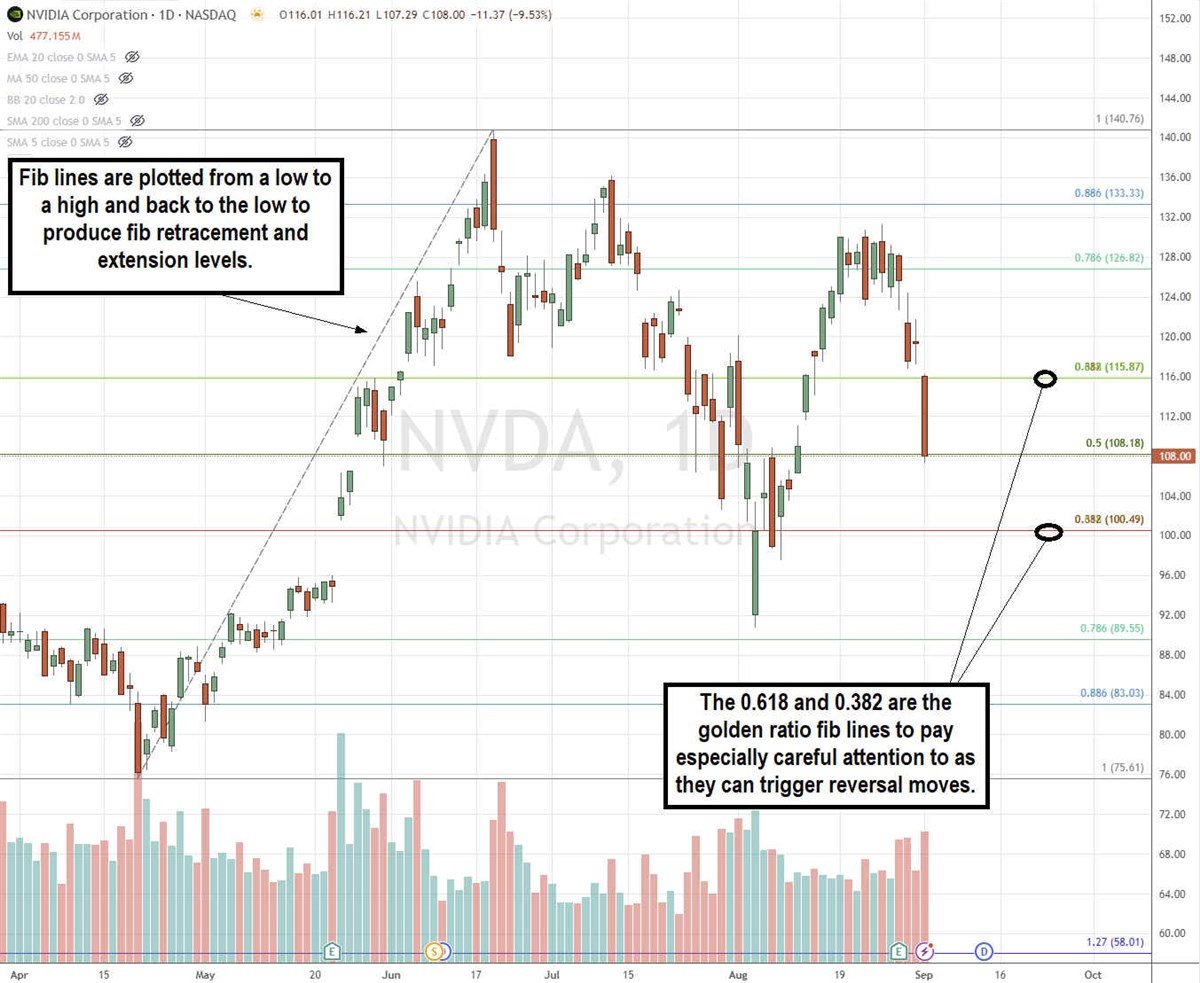Introduction to Fibonacci Retracement Levels

Two emotions rule financial markets: fear and greed. Fear can arise when a stock position is losing money, and greed rears its head when a stock position is making money. The fear of missing out (FOMO) on a potential winner can trigger both emotions. People tend to react when fear or greed builds up too much tension, and investors tend to pull the trigger at the worst moments, like stopping out of a position at the lows or chasing positions at the highs. These reactions happen so often that they can be measured mathematically with Fibonacci retracement levels.
The Fibonacci Series Is Found in Nature
Leonardo Fibonacci was an Italian mathematician who created the Fibonacci sequence. The sequence is derived by adding the prior prime number starting with 1. The sequence goes 1, 2, 3, 5, 8, 13, 21, and so forth. This series of numbers was often found in nature, like flower petals or the growth of branches on a tree.
Deriving the Golden Ratio From the Fibonacci Series
If you divide the prior number into the forward number or vice versa, a common ratio deemed the golden ratio of 0.618 or 1.618 results. This golden ratio can be used to measure the curvature of a snail shell to the formation of galaxies. Most importantly for traders, it can be used to plot price inflection points on charts that trigger emotionally driven reactions, fear, and greed. For trading charts, we like to use the following derivations of the golden ratio: 0.382, 0.50, 0.618, 0.786, 0.886, and the extensions 1.27, 1.414, and 1.618.
Here's How Math Plays Into Emotions
Imagine if you bought the stock at $10 because an analyst gave a $20 price target. Unfortunately, the stock price starts to drop and continues to fall lower and lower as fear sets in. The fear of even deeper losses finally makes you pull the trigger to stop out at $6.18, and then it bounces! As it pertains to financial markets, emotional reactions can be measured, timed, and anticipated using Fibonacci ratios (Fibs).
For example, if a stock rises from $1 to $10, the Fibs forecast profit-taking and stop-loss selling to subside at the 0.382 pullback retracement level at $6.18, potentially triggering buyers to step back into the stock and lift the price. A deeper pullback to the 0.618 golden ratio level to $3.82 would be an even more powerful capitulation level, where fear has washed out all sellers as buyers dive back in. We've all witnessed these typical reactions, and we can track them on the charts.

Computer and technology sector leader NVIDIA Co. (NASDAQ: NVDA) daily candlestick chart Fibs illustrate the various price inflection points.
Plotting Fibs on Your Charts
The Fibonacci price levels on a chart are referred to as Fibs. Many charting packages have drawing tools that include Fib retracement. You can use this tool to plot the Fib levels between a low and a high point on a stock. These are the mathematical support and resistance levels after applying Fibonacci ratios 0.382 or 38.2%, 0.5 or 50%, 0.618 or 61.8% golden ratio, 0.786 or 78.6%, and 0.886 or 88.6%. The extensions can be applied with 1.27, 1.414, and 1.68.
The Starting Plot Points Are Significant
The tricky part of Fib plotting is determining your starting point and which time frame(s) to use. Additionally, plotting too many Fibs will result in a lot of noise in the form of numerous lines. Using a 60-minute chart with swing highs and lows is a good starting point for intraday traders. Swing traders can use the weekly and daily charts to swing highs and lows. Plot the swing low to the swing high, then plot the swing high back to the swing low.
Pay Attention to the 0.618 and 0.382 Fib Levels
Pay special attention to the 0.618 and 0.382 Fibs, as these levels tend to have the sharpest price reactions, breakouts or rejections. When playing earnings gappers, a quick shortcut can be taken by adding a set of 5-minute Fibs plotting the prior day's 5-minute swing low into the close and opening swing high.
Fib Extensions Are Important Price Target Levels
Once you plot your Fibs, they remain static until the stock breaks the price range. By adding the extensions of 1.27, 1.414, and 1.618, your Fibs can remain effective beyond the retracement ranges. The beauty of Fib plotting is the charts will tell you if they are effective just by seeing the historical reactions at the Fib inflection points. Keep in mind that every Fib level won't be significant, nor will prices reverse and break levels exactly at the Fib price line.
Adding a Predictive Element With Fibs on the Charts
Regardless of your trading methodology, Fibs add a predictive element to the price indicators that may not be visible with other pricing indicators like moving averages, Bollinger Bands, and pivots. Fibs are the most effective when price levels overlap with other pricing indicators, like a 200-period moving average, to present multi-layered support or resistance levels. This enables traders to prepare for a price reaction and anticipate initial reversions to fade or breakout and breakdown levels to enter.
Fibs Should Prove Their Worth
While not always right, Fibs tend to be right more often than not. Pay attention to how the Fib levels act as support and resistance levels. Fibs are the core measurement component for harmonic patterns and Elliott Wave trading. Some of the applications can be obscure and they come with plenty of critics. We like to stick with what works in current markets, and anything that can provide an edge is worth including in the trading methodology. Take them for a test drive and see for yourself if they are worthwhile.
Source MarketBeat
NVIDIA Corp. Stock
Our community is currently high on NVIDIA Corp. with 298 Buy predictions and 28 Sell predictions.
With a target price of 124 € there is a positive potential of 28.27% for NVIDIA Corp. compared to the current price of 96.67 €.




